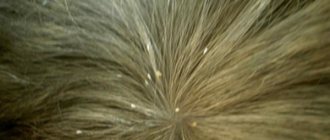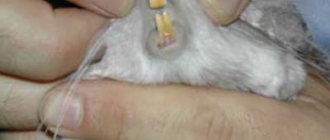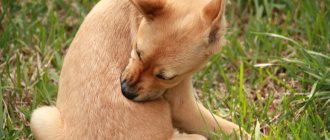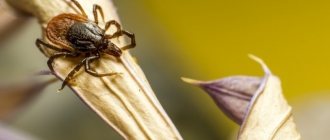- home
- Chinchilla
- Health
03/25/2019 If you periodically notice your chinchilla itching, you should not immediately sound the alarm. All animals do this sometimes, but if the animal bites itself and itches constantly, examine it. The condition of the rodent's skin determines whether it needs the help of a veterinarian, or whether a minor correction of care is sufficient.
If the chinchilla does not lose hair, it has clear skin without redness, blisters or peeling; it may itch due to the dry air in the room. In this case, limit bathing in the sand to once a week or use a humidifier. Otherwise, you need to show the animal to a specialist and carry out the treatment recommended by him.
Why does a chinchilla itch or bite itself and what to do about it?
If you periodically notice your chinchilla itching, do not immediately sound the alarm. All animals do this sometimes, but if the animal bites itself and itches constantly, examine it. The condition of the rodent's skin determines whether it needs the help of a veterinarian, or whether a minor correction of care is sufficient.
If the chinchilla does not lose hair, it has clear skin without redness, blisters or peeling; it may itch due to the dry air in the room. In this case, limit bathing in the sand to once a week or use a humidifier. Otherwise, you need to show the animal to a specialist and carry out the treatment recommended by him.
Colds
If a chinchilla sneezes, becomes lethargic, mucus comes out of its nose, and its body temperature is noticeably elevated, the animal has a common cold. The disease is not so harmless - improper treatment or untimely provision of assistance can result in death. Colds most often occur as a result of hypothermia or after being exposed to a draft. Treatment consists of a course of antibiotics for five days, as well as an abundance of succulent food rich in vitamins, additional ascorbic acid dissolved in warm water, an insulated house and complete rest.
Symptoms of ectoparasite infection
Ectoparasites are parasites that live on the outer surface of the body of an animal or human. These include fleas, lice, and ticks. Chinchillas are infected with them relatively rarely due to their dense fur, but this possibility cannot be excluded until examination and testing are carried out.
The presence of parasites is detected by characteristic symptoms:
- the animal bites its fur, twitches and rubs its back against the wall;
- scratches the skin until it bleeds due to severe itching;
- the fur becomes brittle and falls out, especially on the head and paws, where it is less dense;
- bleeding ulcers and bumps appear on the skin;
- in serious cases there is swelling and suppuration.
Article on the topic: Porphyrin in rats: why there is bleeding from the nose and eyes
Attention! If treatment is not treated promptly, the pet may die from exhaustion or blood poisoning.
Inspection rules
To understand whether there is a problem, you need to examine your pet's paws and ears. In these places, the fur is sparse and the skin is thin. Sometimes parasites settle on the stomach and head. A flea can live on a chinchilla's back, but this area is the last area to become infected.
It is extremely rare to see parasites through fur. In the event of any threat, insects quickly hide in thick fur, so a person does not have time to notice them. However, brown feces and flea eggs can be seen on light-colored fur. The latter look like small dark grains.
You can understand that a chinchilla is infected by the following indirect signs:
- Itching. Appears in the early stages of a pet. It disturbs the animal even during sleep.
- Bites. Marks appear on the skin that can be confused with rashes.
- Deterioration in appearance. With severe infection, the body becomes depleted. The chinchilla is losing weight and losing hair.
- Anemia. With the development of anemia, the mucous membranes become pale.
Chinchillas have quite thick fur and it is very difficult to see the insect during inspection.
The main parasites of chinchillas
There are several types of ectoparasites that are found in chinchillas.
Fleas
These wingless insects jump high and cling to animal fur with their claws and bristles. The flea's body length ranges from 1 to 5 mm, and its mouthparts are designed to pierce the host's skin and feed on blood. They carry pathogens of dangerous diseases such as typhoid, plague, and hepatitis.
Chinchillas can become victims of cat, rabbit and rat parasites. When infected with fleas, the animal itches, hair falls out, and bites resembling warts appear near the face and on the limbs. Insects can be detected by parting the fur.
Lice and lice eaters
Both types of parasites live in the fur of mammals; the sizes of individuals vary from 0.5 to 10 mm. Lice feed on blood, and lice eaters feed on blood and skin particles. They reproduce quickly, laying white eggs - nits that stick tightly to the hair.
These insects also carry infections that are dangerous to people and pets. Their bites cause severe itching and anxiety in animals, as well as scratching on the skin.
Ticks
Chinchillas are parasitized by subcutaneous and ear mites that live in the upper layer of the epidermis. Because of them, bumps, peeling and crusts appear on the skin, the animal often itches and experiences severe discomfort.
The diagnosis is made after microscopic examination of the scraping. Curing a pet from ticks is quite difficult and is often possible only in the initial stages: first, the animal is cut, then washed in a 0.5% bromocyclene solution 4 times at intervals of 8 days.
Ear diseases
If an animal has red ears that constantly itch and discharge pus or an unpleasant odor, this is inflammation. Inflammation of the outer ear is most often the result of improper maintenance. The disease is accompanied by severe itching, anxiety, and the animal may lose its appetite. If treatment is not started, a much more serious disease may develop - otitis media. For treatment, ordinary ear drops are used, which are sold in every veterinary pharmacy. A few drops are dropped into the auricle, the ear is massaged, then cleaned with a clean cotton swab. The procedure can be repeated twice a day for 7 - 10 days.
How to get rid of parasites
Never try to cure a chinchilla of parasites on your own using popular pet medications. At best, this will not bring results; at worst, the wrong dosage will lead to poisoning. The veterinarian must make a diagnosis and prescribe the necessary medications.
Article on the topic: Why doesn’t the red-eared turtle grow, what should I do?
When treating fleas, a special collar for pets is successfully used. If your chinchilla is infested with insects and there are dogs or cats in the house, they should also be treated.
To get rid of parasites, be sure to disinfect the enclosure, change the filler, bedding and sand. It is also necessary to clean the entire apartment.
Salmonellosis
Salmonellosis is one of the most dangerous, but not so common, diseases of chinchillas. The danger is that the disease is transmitted to humans. The source of the disease is food or water contaminated with bacteria. The disease can occur in two forms:
- Spicy,
- Chronic.
In the first case, signs of the disease: severe diarrhea, refusal to eat, rapid weight loss. Treatment of the acute form of salmonellosis rarely brings positive results - the animal dies from exhaustion within a few days and most veterinarians, having diagnosed the disease, advise euthanizing the pet. The chronic form can develop over a long time, periodically accompanied by severe diarrhea and apathy, refusal to eat, and anxiety. Diagnosis of the disease in the chronic stage can only be done by testing for resistance. Treatment is prescribed by a veterinarian depending on the severity of the disease and the condition of the animal.
Self-treatment is more likely to lead to the death of the chinchilla.
Ringworm or fungus in chinchillas
If your pet itches and bites itself, the cause may be a fungal skin disease - ringworm, or ringworm. Signs that distinguish the disease:
- hair loss in certain areas;
- peeling of the skin;
- formation of crusts and red spots;
- sometimes discharge of pus from wounds.
A chinchilla usually easily tolerates the disease, but if it is neglected, the animal can become completely bald, and the fungus can also affect other organs.
Diagnosis is carried out using an ultraviolet lamp in a dark room: with dermatomycosis, areas of the skin glow green. This test does not detect ringworm caused by some types of fungi; in such cases, skin and hair samples are taken for microbiological analysis.
Factors that increase the risk of disease:
- chronic stress;
- avitaminosis;
- malnutrition;
- high air humidity;
- poor hygiene;
- contact with the vector.
Ringworm is an unpleasant disease, but relatively easy to treat. Therapy is prescribed by a veterinarian; drugs such as clotrimazole, lamisil, exoderil, etc. are usually used. There is a vaccine against fungus that is administered to chinchilla puppies after 6 months.
Ringworm is easily transmitted to humans, so a sick animal should be isolated and touched only with gloves.
Prevention of parasite infection in chinchillas
To prevent your pets from becoming infected with ectoparasites and fungi, you need to follow several rules:
- buy quality food and fillers;
- wash the cage and walking areas every day;
- Completely disinfect the cage at least once a month;
- keep chinchillas in a spacious enclosure;
- ventilate the room regularly;
- before adding a new resident to the enclosure, place him in quarantine for 1.5 months;
- wash your hands and change the clothes you came in from the street in if you are going to touch the animals;
- Include essential vitamins and minerals in their diet.
Article on the topic: Why does a rat go bald and molt, hair loss in rodents
If tests do not show infestation with parasites, the chinchilla may chew out its own fur due to stress associated with moving or moving in with relatives. In this case, she is moved to a separate cage for several days, covered with a dark cloth. Other causes of biting include vitamin deficiency, allergies, and other diseases.
Preventing infections is easier than treating them. Follow the rules for caring for chinchillas, and the animals will be best protected from parasites. If you notice signs of infection in them, contact your veterinarian.
Urinary system disease
Cystitis usually affects adults. Both males and females are equally susceptible to the disease. The first signs of cystitis are problems with urination, anxiety, the animal bites its sides, squeaks often, and becomes inactive. If signs of illness appear, you should immediately consult a doctor. Self-treatment of the disease without prior examination can only harm the animal. Very often, the internal cause of cystitis is sand or even kidney stones.
What to do if your chinchilla has fleas
Today, many lovers of furry pets have a chinchilla in their home - a cute and quite active animal. This attractive animal has not only amazing beauty, but also a cheerful, friendly character. In addition, the chinchilla is very unpretentious in maintenance. According to many people, its unusually thick fur serves not only as an decoration for the animal, but also as an obstacle to the appearance of blood-sucking insects. This article will tell you whether chinchillas really have fleas.
Routes of infection
All warm-blooded animals on earth are susceptible to attacks by parasites such as fleas. Chinchillas are no exception. Even if the animal spends all its time in the apartment, this does not mean that it is protected from the pest. Fleas can appear in chinchillas for the following reasons:
- It is enough to have other pets in the house. One of the most common ways to infect a furry creature is to have a dog or cat in the house that regularly leaves the house.
- A person can also bring fleas into the house on outer clothing or shoes.
- It’s not for nothing that fleas are called jumping champions, since in search of their prey they are able to cover very long distances in a very short time.
- The most favorite habitats for fleas are basements and attics, from which insects can enter the house through the ventilation shaft.
- You should also not exclude the possibility that the chinchilla got fleas while at the pet store. Therefore, when buying an animal, you should pay attention to this nuance.
- Another source of infection for a furry rodent is hay, which is most often sold in pet stores or poultry markets. When placing an animal’s favorite treat in a cage, it is necessary to carefully inspect it.
Article on the topic: Pneumonia in red-eared turtles and land turtles: symptoms and treatment at home
Stomatitis
Chinchilla diseases are often infectious. One of the most common infectious diseases is stomatitis.
Stomatitis in chinchillas is most often caused by a viral, bacterial or fungal infection, and the cause is a weakened immune system, lack of iron in the body, or severe infestation with worms.
Symptoms are increased salivation, constantly wet fur around the mouth and on the chest, refusal to eat, strong and unpleasant breath. What should you do if you notice these signs? Stomatitis must be treated by treating the animal’s oral cavity three to four times a day with Metrogildent or Lugol. It is also recommended to rinse the chinchilla's mouth with Chlorhexidine.
Infectious stomatitis in chinchillas
Symptoms of infection
A parasite bite poses a serious danger to the health and even life of a chinchilla, since the pest is a carrier of various infections. And if there is an excessive accumulation of parasites in the animal’s fur, large blood losses are possible, leading to anemia. You can tell if your pet is bothered by blood-sucking insects based on the following signs:
- restless behavior;
- the animal itches very often;
- the injured area of skin turns into something like a wart;
- the presence of flea excrement in the animal’s fur, which looks like black grains;
- A particularly serious case is indicated by hair loss.
Preventive examination
As soon as the animal gets into your home, carefully examine its paws and ears. The fur on these parts of the animal’s body is much less dense than on the body, and parasites prefer to feed there. The skin is clean, no ulcers or scratches found, no insects? Everything is fine. Your animal is healthy.
You can tell that a chinchilla has fleas by indirect signs:
- The chinchilla experiences constant itching and cannot sleep peacefully. Losing weight.
- Dermatitis appears on the skin.
- The fur is falling off.
- Black specks are visible in the fur - flea droppings.
- Anemia occurs - the nose, gums and other mucous membranes turn pale, the animal weakens.
Attention. Many believe that chinchillas do not have fleas, since the thickness of their fur and love for swimming in fine sand prevent parasites from settling in their fur coat. But it is not so. They do not have their own parasites, but cat and dog fleas brought in from the street do not bypass any potential hosts.
How to treat a chinchilla for fleas
Treatment for fleas on an animal consists of treating the animal itself, its bedding and cage. As a disinfectant, you can use a solution made from vinegar and tar soap. The entire room must also be treated. In the absence of such comprehensive measures, it will not be possible to achieve a positive result - after a while, the fleas will attack the chinchilla again.
Sometimes, to treat chinchillas, they practice the use of antiparasitic agents intended for larger four-legged friends - dogs or cats. However, it should be taken into account that the dimensions of the furry animal are several times smaller, which means the dosage of the chemical must be different. Therefore, the use of anti-flea drops, sprays or powder in this case is not recommended. The best option is a collar for dogs or cats. It will not harm the pet, as it has a lower degree of toxicity.
Flea collar for chinchillas
Now you know that chinchillas have fleas. And if they are indeed detected, then ideally it is preferable to seek help from a veterinarian.
Mastitis
Mastitis in chinchillas develops during the feeding period. The cause of the disease most often lies in staphylococcus bacteria, which enter the mammary gland through small cracks. The result is that the nipples turn red, the body temperature rises, and the female experiences severe pain during feeding. If you take the babies away during illness, the female’s condition will only worsen. Suppuration may begin in the mammary gland, the treatment of which is impossible without surgery. Treatment of mastitis involves the use of sea buckthorn oil. It is rubbed into the chinchilla nipple area with slight pressure. Regular pumping of milk sometimes helps.
A compress made from ordinary cabbage leaves has also proven itself well.
Reviews
Chinchillas can have fleas. I verified this personally when I brought my pet to the veterinarian. He advised me to purchase a flea collar. Now my pet is cheerful, playful and doesn’t itch at all.
Article on the topic: Diarrhea in chinchillas: what to do in case of indigestion and loose stools (symptoms, prevention, treatment)
In the summer we often had to go to the dacha, and we took our chinchilla with us. Although there were no other animals nearby, she somehow managed to pick up parasites. After which it began to itch very much. My wife saw the fleas in the cage when she was cleaning it. They took the animal to the veterinarian, where they dropped something on her neck, and that’s it - there were no more problems.
I never knew that chinchillas have fleas. An acquaintance convinced me that insects could not breed in such thick fur.
Why does a chinchilla itch?
Occasional scratching is not a cause for alarm. Cats, dogs, and people itch periodically. Chinchillas also have the luxury of scratching themselves just because. However, if scabies occurs frequently, have your pet examined. If the chinchilla does not have bald spots, the skin is clean, without peeling, just limit bathing in the sand to 1-2 times a week; perhaps the skin is just a little dry, especially in winter, when the air in the room is dry. However, if there are symptoms of irritation, and the chinchilla chews out the fur, then the causes of the itching may be much more serious. In this case, you can’t figure it out without an experienced veterinarian.
Ringworm or fungus in chinchillas
The most common fungal skin diseases in chinchillas are mycoses caused by Trichophyton mentagrophytes and microsporia caused by Microsporum canis or Microsporum gypseum. Symptoms of these diseases may include the formation of round bald patches with reddened skin, sometimes covered with scabs. The diagnosis is made by scraping the skin from the affected area. Treatment is prescribed only by a veterinarian. The following drugs can be used in treatment:
- 1. Clotrimazole – 1% solution
- 2. Lamisil – spray
- 3. Exoderil - solution
- 4. Nystatin - crushed tablet is added to the sand
- 5. Fungi Stop is a veterinary antifungal agent that is rubbed into the fur.
- 6. Medical sulfur - rubbed into the affected areas, can also be added to the bath.
- 7. Antifungal tablets are prescribed by a veterinarian when the disease is difficult to treat only with external means. These may be griseofulvin or nizoral. The course and dosage are also only as prescribed by a specialist.
- 8. Vakderm F is a vaccine intended for the prevention and control of lichen. Age is a contraindication - chinchillas should not be injected until they are 6-7 months old.
Sources:
https://homjakam.ru/shinshilla/zdorovie/cheshetsya-ili-pokusyvaet-sebya https://apest.ru/blohi/vse-o-blohah/byvayut-li-u-shinshil-blohi/ https://gryzuny .com/pochemu-shinsilla-cheshetsya.html











